The Regional Climate Centers (RCC) program was initiated by the National Oceanic and Atmospheric Administration to complement the activities of the state climate offices (most states have one) and the two national centers (the National Climatic Data Center, NCDC, in Asheville, North Carolina; and the Climate Analysis Center, CAC, a part of the National Weather Service in Washington, D.C.). Thus, there is now a system of national, regional and state climate centers. The RCCs, administered by the CAC, operate under contract to the federal government, and personnel are employees of their respective state institutions or governments. Many of the individuals associated with the RCC program, including several former state climatologists, have had substantial and invaluable experience with the existing complex U.S. climate service structure.
Over a period of 10 years the present network of six centers serving the United States was funded and developed. Regional centers now exist in the Northeast, Southeast, Midwest, High Plains and the West. In 1990 the last of the six, the Southern RCC, was established. The Caribbean Islands are formally linked with the Southeast RCC, Alaska and the Pacific Islands with the Western during 1992.
The centers perform four principal functions:
- Maintain regional historical weather and climate databases
- Disseminate, interpret, summarize, and manipulate climate data and information for the benefit of users in universities, government agencies, and private org anizations and individuals
- Conduct applied and some basic research on regional climate issues
- Serve as a focal point for coordination of climate activities among agencies and organizations
Activities at each RCC are divided into two components:
- Operations and services
- Research and development
Each center has agreed to provide a set of minimum baseline capabilities, and all computer systems are now linked via the Internet. Differences among the RCCs reflect regional needs; for example, private-sector interests in agriculture and transportation are strong in the Midwest whereas, in the West, natural resource management by federal agencies is a significant factor. A system of review and oversight is being instituted to insure that the RCCs interact effectively with each other, with other climate service entities, and with their constituents. Interactions between the LTER Network and the climate community were recently featured at the April 1992 9th annual PACLIM meeting in Monterey, California.
It is not possible to understand the functioning of natural ecosystems without accounting for the prominent role played by atmospheric and hydrologic interactions, which occur over a range of spatial and temporal scales spanning many orders of magnitude. Although most of the LTER sites have only recently begun atmospheric measurement programs, a considerable body of historical data from the same or nearby sites is available for research purposes. Access to this information can be initiated by contacting the relevant state, regional and/or national climate center.
Additional information on RCCs is contained in a recent issue of the Bulletin of the American Meteorological Society (7 1:527-537), or may be obtained from Kelly Redmond, Regional Climatologist, Western Regional Climate Center Desert Research Institute, P.O. Box 60226, Reno, Nevada 89506, 702-677-3139, krwrcc@nimbus.unr.edu (Internet).

 Enlarge this image
Enlarge this image